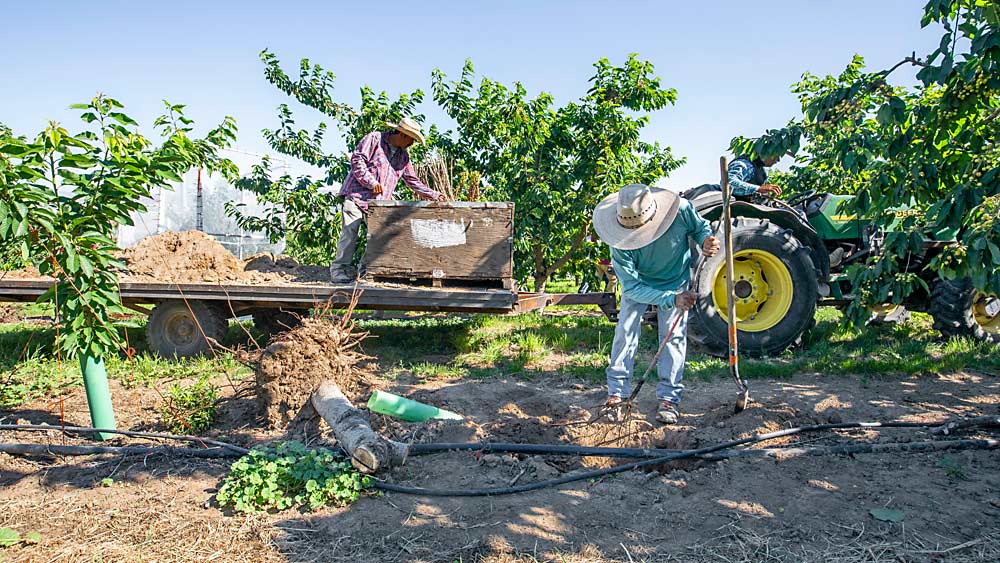
Before replanting individual cherry trees within a block to replace those lost to X disease, grower Craig Harris instructed crews to dig out the holes by hand and remove every single root. They also planted the new trees with fresh soil hauled into the orchard.
That’s a lot of time and effort, but Harris wanted to reduce the risk that any remaining root tissue could transmit disease to the new trees in this Moxee, Washington, orchard. In another block that he completely ripped out and replanted, he had crews treat every stump with herbicide, ripped the roots with an excavator, left the site fallow for a year and then fumigated before replanting.
But is all that effort reducing disease risk to a meaningful degree, or is it just making Harris feel like he’s doing all he can? To answer that important question, he invited researchers from Washington State University to track the success of his replanting practices.
“If we need to do it, we’ll do it,” he said, but it would be welcome news to learn that all the extra efforts are unnecessary. “They are looking at a bunch of scenarios to see what are the chances that live root tissue can infect the new trees.”
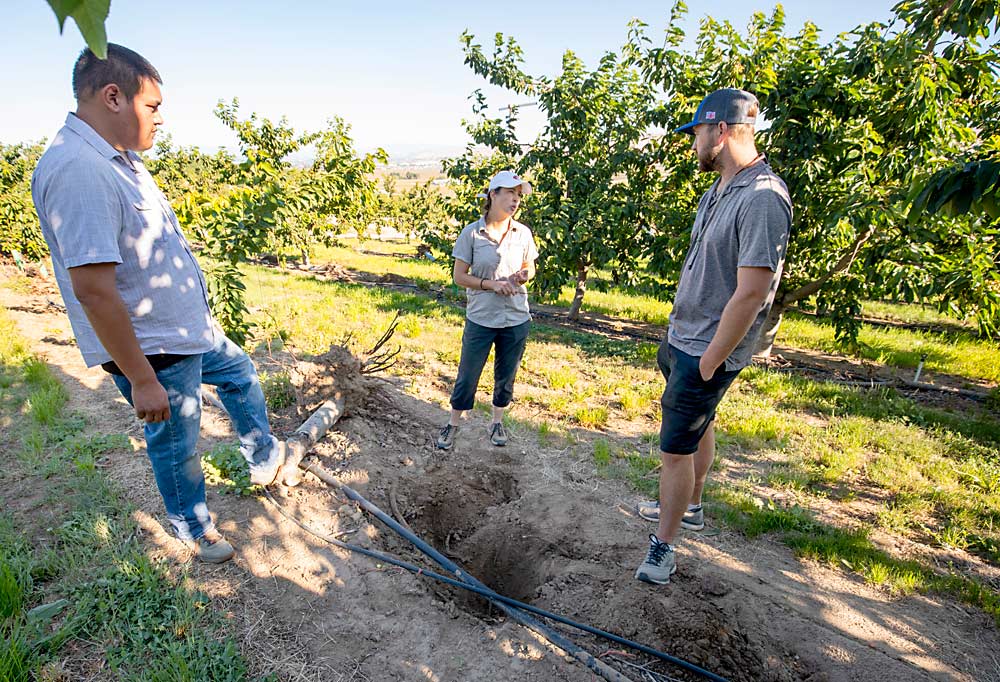
Harris’ replanting approach is one of 10 orchard sites selected in Washington and Oregon as case studies to examine the risk root-to-root infection poses when replanting after X disease. The project, led by Oregon State University extension specialist Ashley Thompson and WSU extension specialist Bernardita Sallato, is funded by the Oregon Sweet Cherry Commission and the Washington Tree Fruit Research Commission, for which Harris serves as a commissioner.
Answering questions about replanting after tree removal is imperative for Northwest growers. A recent WSU survey found that almost 1,000 acres of cherry trees have been reported removed in recent years, due to little cherry disease, at an estimated $115 million cost, considering lost revenue and establishment costs, said WSU extension specialist Tianna DuPont during a presentation at North Central Washington Stone Fruit Day in January.
Little cherry disease is the umbrella term for the disorder caused by different pathogens that produce similarly unmarketable fruit: two little cherry viruses and the far more common X phytoplasma that’s driving the current epidemic and is the focus of this research project.
Growers want to know the best way to remove X disease-infected orchards, because if they must remove trees, they are eager to replant, Thompson said while presenting a project update to the research commission late last year.
“As we all know, X disease can be transmitted via root grafting, so it’s important to know survival of roots under different replant strategies, and risks those pose to young plantings,” she said. “The goal of this research is to provide orchardists with science-based replant strategies.”
Replanting a block in an area facing high X disease pressure is inherently risky, Sallato added. The leafhoppers that transmit the disease pose a much larger risk than the root-transmission risk this project focuses on minimizing.
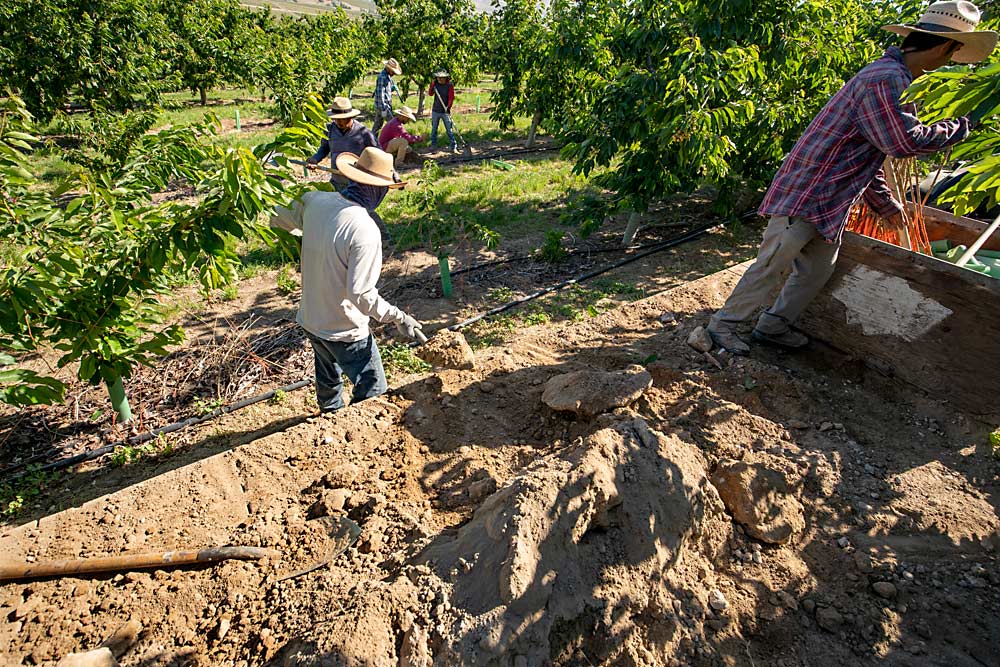
Remove
Removing infected trees, of course, starts with finding them. WSU recommends sending scouts down every row shortly before harvest, looking at both sides of the trees for signs of symptomatic fruit. Trees should be flagged for follow-up testing (which can be skipped if you already know the disease is present in your block) and then removed after harvest. For removal, WSU recommends applying glyphosate to the symptomatic trees, to check if they have root-grafting with any adjacent trees and to kill the infected roots before removal.
Herbicide can be applied several ways, such as to the cut stump or using the frill method. Both work, but DuPont said in case studies she’s reviewed, the frill approach performed slightly better. Sallato recommends leaving one leader on the tree after the first pass with the chainsaw, so that the tree continues to move the herbicide that’s painted onto the cut stump.
Without carbohydrates from the leaves moving into the roots, the herbicide may not move around enough to kill all the roots, she said. Plus, that gives growers the satisfaction of seeing the infected trees die.
The goal is to kill as much of the root tissue as possible, Sallato said. Unlike a fungal pathogen that can live for years on dead roots in the soil, the X phytoplasma can only survive on live roots.
For the research project, Sallato and Thompson are looking at root survival, testing root samples to see if infected roots remain, and placing insect netting cages around young trees to prevent transmission via leafhopper vectors while they monitor for infection via root-grafting.
If the young trees in cages remain healthy for the three years of the project, that will suggest that there’s no soil-driven infection. At Harris’ block where individual trees were replanted, all 10 trees Sallato tested were negative, despite finding in the soil a few live, infected root pieces that survived the herbicide treatment on the site.
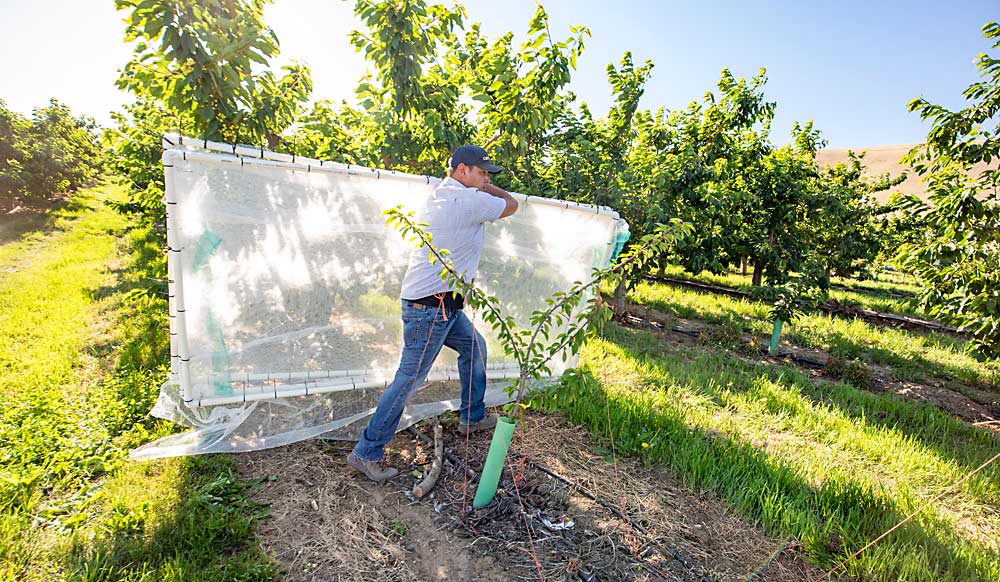
That’s promising, she said, but more data is needed.
“My theory is that having an infected root piece (just in the soil) is not a big risk, because it needs energy to root-graft,” she said.
Thompson said there’s just not enough information about how cherry trees root-graft, especially with some of the newer, smaller rootstocks. She hasn’t seen much evidence of root-grafting in The Dalles, Oregon, growing region.
“We don’t suspect that there is a lot of root-grafting going on between the big old chunks of root and young trees,” she said. “But it’s hard to tell. That’s why we are doing this study.”
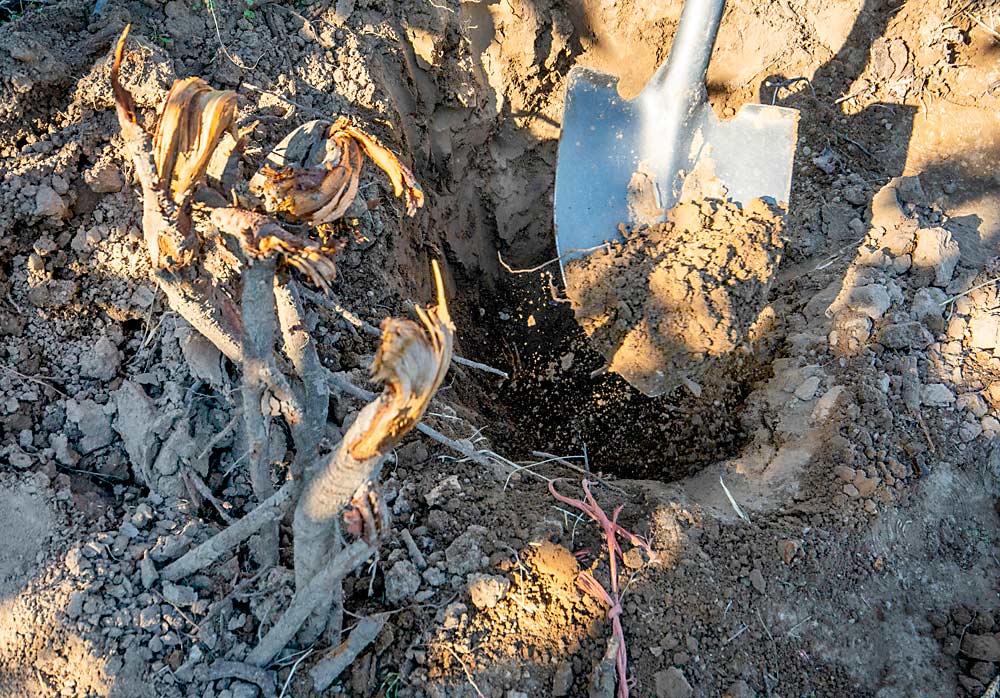
Replant research
The study follows 10 orchard sites representing a variety of approaches to tree removal and replanting. Some used herbicide on the stumps, some didn’t. Some took extra care to rip out roots, some just used their standard practices. Some used fumigation, some didn’t. Some left the ground fallow for a year or more, some planted the next spring.
Casey Pink, a grower in The Dalles, volunteered two orchard sites he recently leased and was preparing to replant. At his home farm, a few miles away, he hasn’t found any X disease, so it’s been a learning experience, he said.
“Replanting is very expensive,” he said, and growers want to protect that investment. “Anything we can learn is a benefit to us in the future.”
One block had already been removed the year prior to his lease, and he and his son removed the other block with an excavator, bringing up the large Mazzard root systems with the stumps.
“We didn’t treat the trees with Roundup first. We don’t have much experience with (X disease),” he said, but they sprayed the few suckers that came up. “I was mostly concerned about roots surviving, but I can’t imagine any live roots in there if every shoot was dead.”
He didn’t fumigate — “I would if I could,” Pink said, but it’s too hilly. He left one site fallow for one year, the other for two. Then, before planting, they ripped the dry soil in three directions, about 3 feet deep.
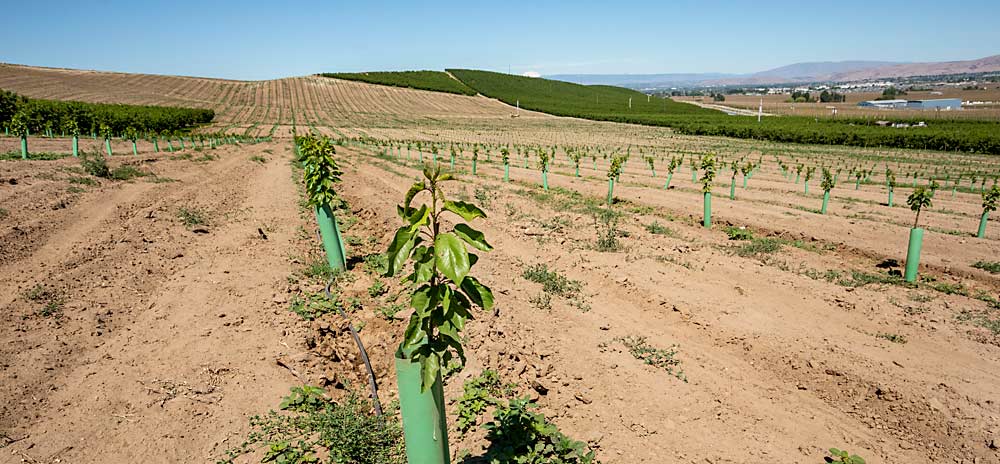
Fumigation may not be very important for X disease, Thompson said. It’s not penetrating and killing larger roots, and the pathogen doesn’t live in the soil outside the roots. But fumigation does reduce other soilborne pest pressure that can impact young trees in replant sites, so opting for clean soil could have benefited the individual replants in Moxee, Sallato said.
With more data, Thompson and Sallato hope to share more informed recommendations about what’s necessary — and what’s not — to replant safely. But Thompson urged growers not to wait for more findings on the best way to remove trees before they start removing them.
“We know the absolute most important strategy is to remove sick trees and control your weeds and leafhoppers,” Thompson said. “Just remove your sick trees.”
—by Kate Prengaman

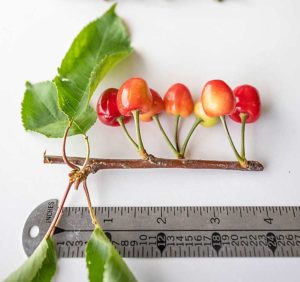
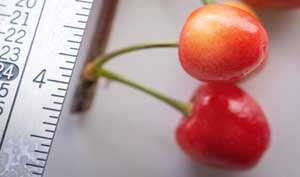
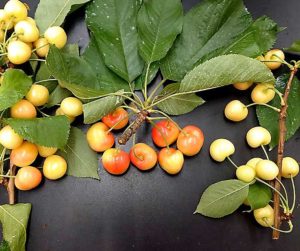





Leave A Comment